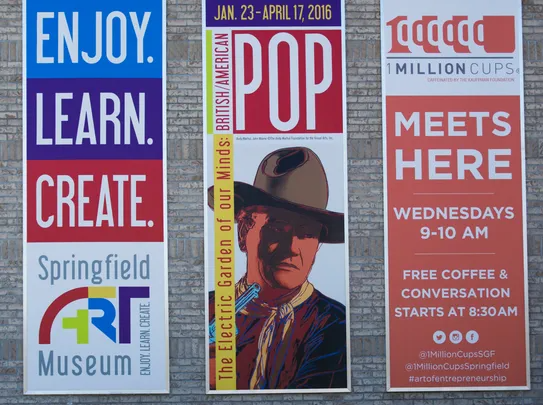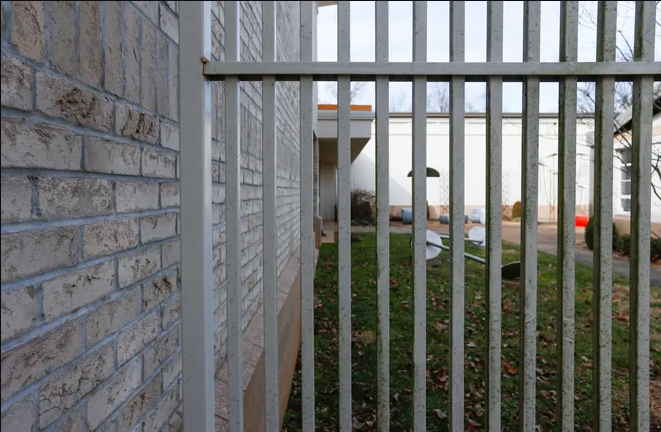Over eight years ago, on April 7, 2016, seven of the ten silkscreen prints from set 31 of Andy Warhol’s “Campbell’s Soup I” series were stolen in an overnight burglary from a pop art exhibit at the Springfield Art Museum in Springfield, Missouri. The prints stolen were Warhol’s monumental depictions of Campbell’s Beef, Vegetable, Tomato, Onion, Green Pea, Chicken Noodle and Black Bean Soup cans.
A Little History About Where the Theft Happened
The beginnings of the Springfield Art Museum, the city’s oldest cultural institution, sprang from a seven-member women’s Art Study Club formed in 1926 by Deborah D. Weisel, an art instructor at Springfield State Teachers College (now Missouri State University). The club incorporated as the Springfield Art Museum in 1928, coincidentally the year that Andy Warhol was born in Pennsylvania. At that time, the museum began to bring traveling exhibits from other cities, including New York, Philadelphia and St. Louis, to Springfield. The art study club deeded the museum to the city of Springfield eighteen years later, in 1946. The study club became the Southwest Missouri Museum Associates, a group that continues to support the museum to this day.
The museum resided in Springfield’s City Hall from 1930 until 1958, when it moved to a new building in Springfield’s Phelps Grove Park. Two years later, the new museum added a courtyard patio and was lauded for its “tasteful intimacy” by an art critic for the St. Louis Dispatch. That art critic found it “startling to learn of a museum that genuinely serves as a cultural center for its community” and, perhaps displaying an unwarranted big city bias, described finding this museum “in a small midwestern city” as “distinctly ironic.”
In 1962, the Springfield Art Museum began an annual exhibit tradition that continues 63 years later – Watercolor USA, a national juried competition that recognizes contemporary American watermedia painting. That was the same year that Andy Warhol exhibited his soup can paintings for the first time in a Los Angeles gallery. In 1985, the Greenberg Gallery in St. Louis donated Set 31 of Warhol’s “Campbell’s Soup 1” screenprints, consisting of 10 different soup can silkscreen prints, to the Springfield Art Museum. Due to the fragile nature of paper, those screenprints were rarely displayed at the museum, but were part of a 2006 Andy Warhol exhibit that included paintings of athletes loaned by a California collector.
The museum, which today has more than 10,000 objects, has continued to expand throughout its history. It added a 400-seat auditorium in 1974, a new wing in 1994, and a new entrance, lobby, museum shop and additional galleries in 2008. The museum recently closed to the public, after Labor Day 2024, for a major expansion and renovation project that is expected to be completed in early 2028. While its main buildings are closed for construction, the museum will continue to present exhibits, programs, classes and events at various locations in downtown Springfield.
How the Theft Happened
On January 23, 2016, the Springfield Art Museum opened a new exhibit, “The Electric Garden of Our Minds: British/American Pop,” described as “a dazzling show of American and British pop art.” The exhibit included prints by Scottish artist Eduardo Paolozzi, considered to be the father of British pop art, that had been given to the museum by a private collector in 1981, as well as the 10 silkscreen print set of Andy Warhol’s “Campbell’s Soup I.” The prints were hung in the museum’s Spratlen Gallery by nails only.


Sometime between the museum’s closure at 5:30 p.m. on April 6, and its opening to the public at 9:00 a.m. on April 7, seven of the ten Warhol soup can silkscreen prints were stolen. The theft was discovered by a security guard who went to watch video feeds from the galleries just before the museum was to open for the day and noticed the blank spots on the wall in the Spratlen Gallery. Shortly after that discovery, another security guard noticed a “Do Not Disturb” sign placed between two glass doors leading from the galleries to the courtyard that had been added to the museum in 1960. These two guards also found a wood chip stuffed inside the hole in the lock of those doors, which would enable someone to open those doors even though they appeared locked.
Interestingly, according to a February 2019 story by Gregory J. Holman in the Springfield News-Leader, the museum’s alarm system did activate in some way in the early morning hours of April 7, but neither the police nor the museum director were notified. Apparently, a note about the handling of alarms from the museum and instructions on when to call the police or the museum director had been placed by the security company on the museum’s file after a series of false alarms in February 2015. That note was still in place in April 2016. In addition, according to the museum’s director at the time, the surveillance video of that night was too dark to determine how many people were involved in the theft, even to the point of detecting if just one or more than one person had entered the museum that night.
Holman’s story also described how the theft, which took about four minutes, likely happened. Because neither the wrought-iron fence protecting the museum courtyard nor the courtyard gate had been breached, it appears that the thief or thieves somehow came over the top of the fence into the courtyard.



From there, the courtyard door into the galleries was pried open, with the emergency exit sign and wood chip used to keep that door open. The stolen framed Warhol silkscreen prints were thin enough for them to be passed through the bars of the metal gate leading from the courtyard to outside the museum.
No one can explain why only seven of the ten Warhol silkscreen prints were taken, leaving behind the Pepper Pot, Cream of Mushroom and Consummé (Beef) soup can prints – the last three on the wall, going from the exhibit’s left to right. Perhaps it was a concern about an alarm going off and getting out of the museum before the police arrived or the thought that seven Warhol soup cans were enough (or perhaps just a dislike of those soups).
To this day, no information about the thief or thieves or the whereabouts of the stolen Warhol silkscreen prints has been uncovered. At the time of the theft, the complete set of silkscreen prints was valued at approximately $750,000.
How to Identify These Missing Pieces of History
The seven stolen prints are part of Set 31 of Andy Warhol’s “Campbell’s Soup I.” Each print is 37 inches high and 24 ½ inches wide. At the time of the theft, the prints were each in thin white wooden frames. The missing prints are the Beef, Vegetable, Tomato, Onion, Green Pea, Chicken Noodle and Black Bean Soup Cans.



Why These Missing Pieces of History are Important
Warhol’s first Campbell’s Soup Can paintings were shown at Ferus Gallery in Los Angeles in 1962. That exhibition, which totaled 32 paintings, met with a great deal of ridicule. In fact, a neighboring gallery put actual soup cans in its window, labeling them as “the real thing” selling for twenty-nine cents. These original Soup Can paintings, meant to depict objects so commonplace that no one would even notice them, became, of course, infamous images, synonymous with Warhol himself.
In 1968, Warhol produced 250 silkscreen prints of each of the ten soup cans in the “Campbell’s Soup I” series. The following year, he did the same with his next series, “Campbell’s Soup II.” He offered those screenprints for sale at The Factory, his studio in New York City. In a 2016 New York Times article about the theft, Ron Rivlin, the owner of Revolver, a Los Angeles gallery specializing in Andy Warhol’s work, noted that, due to damage, loss or destruction, only 50 complete sets of Warhol’s “Campbell’s Soup I” series were still intact.
What to Do if You Know Where These Missing Pieces of History Are
If you recognize any of the missing soup can screenprints from the Springfield Art Museum’s “Campbell’s Soup I” series (Set 31), have any information about them, or know their whereabouts, please call us at 1-202-240-2355 or send us an email at contact@arguscpc.com. The FBI is offering a reward of up to $25,000 for information leading to the return of these stolen artworks.
